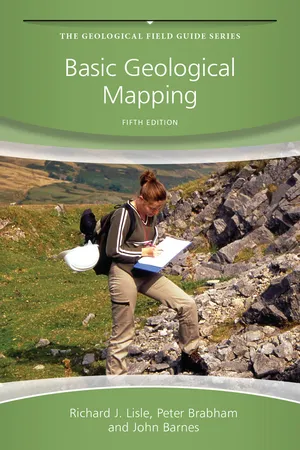
- English
- ePUB (mobile friendly)
- Available on iOS & Android
Basic Geological Mapping
About this book
Part of The Geological Field Guide Series, Basic Geological Mapping, 5 th Edition is an essential basic guide to field techniques in mapping geology. Now completely revised and updated the book retains the concise clarity which has made it an indispensable instant reference in its previous editions. It provides the reader with all the necessary practical information and techniques that they will need while carrying out work in the field, covering a wide spectrum of different conditions, needs and types of countries. This edition covers new developments in technology including Google Earth and the use of GPS. This is an ideal field guide to geological mapping for 2 nd /3 rd year undergraduates of Geology, Hydrogeology and Geological Engineering.
Frequently asked questions
- Essential is ideal for learners and professionals who enjoy exploring a wide range of subjects. Access the Essential Library with 800,000+ trusted titles and best-sellers across business, personal growth, and the humanities. Includes unlimited reading time and Standard Read Aloud voice.
- Complete: Perfect for advanced learners and researchers needing full, unrestricted access. Unlock 1.4M+ books across hundreds of subjects, including academic and specialized titles. The Complete Plan also includes advanced features like Premium Read Aloud and Research Assistant.
Please note we cannot support devices running on iOS 13 and Android 7 or earlier. Learn more about using the app.
Information
Chapter 1
Introduction
1.1 Outline and Approach
1.2 Safety
| Risk | Precautions |
| Fall from steep slopes | Stay away from cliffs, steep slopes, quarry edges, overgrown boulder fields, and so on. Do not rely on Global Positioning System (GPS) but examine a topographic map to identify steep slopes and plan your route. Avoid climbing; leave dangerous exposures unmapped rather than take risks. Do not run down slopes. In mountains but not on a path, stay put in dense mist, fog and darkness |
| Struck by falling rock and splinters from hammering | Avoid rock overhangs; wear a helmet if near cliffs, quarry faces. Do not enter mines or caves. When hammering always use safety goggles and take care with bystanders and passers-by |
| Drowning after being swept away by waves, tides and floods | Avoid the water's edge at sea, lakes and rivers. Consult tide tables. Do not enter caves, mines, potholes. Do not attempt to cross fast-flowing rivers |
| Cannot be reached by emergency services | Work in pairs, or in close association; leave details of the day's route in camp before leaving for the field; wear bright clothing, carry a mobile phone, whistle, torch, flashing LED beacon or a mirror to attract the attention of passers-by or mountain rescue teams |
| Exposure, an extreme chilling arising from sudden drop in temperature | The symptoms range from uncontrolled shivering, low body temperature, exhaustion and confusion. Carry warm clothing and waterproofs, thermal safety blanket, matches, emergency rations (e.g. glucose tablets, water) |
| Motoring accident | Drive carefully on narrow mountain roads; at roadside exposures take care with passing traffic and wear high-visibility jackets. Never drive whilst under the influence of alcohol or drugs. |
1.3 Field Behaviour
- Do not leave gates open, climb wire fences or drystone walls or trample crops, and do not leave litter or disturb communities of plants and animals.
- Do not hammer for the sake of it. Greenly and Williams (1930, p. 289) observe that ‘indiscriminate hammering is the mark of a beginner’ (several key localities once showing beautiful structures have been defaced by geological hammering, drilling and graffiti). When you are collecting specimens do not strip out or spoil sites where type fossils or rare minerals occur. Take only what you need for your further research.
- Before you embark on any field programme you should have studied your public access rights on footpaths using maps or web-based enquiry. In the UK, you do not have the right to walk wherever you want, but open access to many remote areas is now covered by the Countryside and Rights of Way Act 2000. These are typically areas of mountain, moor, heathland, downland and registered common land; further details can be found on the Ramblers website. When in the field always ask permission to enter any private land when not on a public footpath. Most owners are willing to cooperate with geology students if they are asked politely first; landowners are usually very interested in what lies beneath their land, but understandably get very annoyed to find strangers sampling their rocks uninvited.
Table of contents
- Cover
- Table of Contents
- The Geological Field Guide Series
- Title
- Copyright
- Preface to The Fourth Edition
- Preface to The Fifth Edition
- Chapter 1: Introduction
- Chapter 2: Field Equipment
- Chapter 3: Topographic Base Maps
- Chapter 4: Methods of Geological Mapping
- Chapter 5: Technological Aids to Mapping
- Chapter 6: Field Measurements and Techniques
- Chapter 7: Mappable Rock Units and Lithology
- Chapter 8: Field Maps and Field Notebooks
- Chapter 9: Fair Copy Maps and Other Illustrations
- Chapter 10: Cross-Sections and 3D Illustrations
- Chapter 11: Geological Reports
- Appendix A: Adjustment of a Closed Compass Traverse
- Appendix B: Field Equipment Checklist
- Appendix C: Indicators of Stratigraphical Way-Up
- Appendix D: Useful Chart and Tables
- References
- Index
- Selected Map Symbols
- Colour Plates
- End User License Agreement